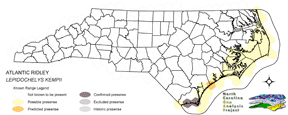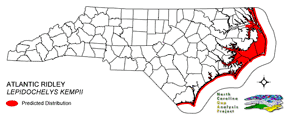
| Taxa: |
| Order: |
| Family: |
| Reptilia |
| Testudines |
| Cheloniidae |
| NatureServe Global Rank: |
| NatureServe State (NC) Rank: |
| G1 |
| SAB,SZN |
| Federal Status: |
| NC State Status: |
| LE |
| E |


| Land Unit |
| US Fish & Wildlife Service |
| US Forest Service |
| US National Park Service |
| US Department of Defense |
| NC State Parks |
| NC University System |
| NC Wildlife Res. Com. |
| NC Forest Service |
| NC Div. of Coastal Mgmt. |
| Local Governments |
| Non-Governmental Org. |
| Other Public Lands |
| Private Lands |
| GAP Status 1-2 |
| All Protected Lands |
| Statewide |
| Hectares |
| 346.05 |
| 4.59 |
| 254.25 |
| 1,024.56 |
| 112.14 |
| 0.00 |
| 33.39 |
| 0.00 |
| 206.91 |
| 0.00 |
| 39.69 |
| 0.36 |
| 3,432.15 |
| 1,313.37 |
| 2,019.51 |
| 5,454.09 |
| Acres |
| 855.11 |
| 11.34 |
| 628.27 |
| 2,531.74 |
| 277.10 |
| 0.00 |
| 82.51 |
| 0.00 |
| 511.29 |
| 0.00 |
| 98.08 |
| 0.89 |
| 8,481.03 |
| 3,245.41 |
| 4,990.32 |
| 13,477.35 |
| % of Dist. on |
| Prot. Lands |
| 17.1 % |
| 0.2 % |
| 12.5 % |
| 50.7 % |
| 5.6 % |
| 0.0 % |
| 1.7 % |
| 0.0 % |
| 10.2 % |
| 2.0 % |
| 2.0 % |
| < 0.1 % |
| 0.0 % |
| 65.0 % |
| ----- |
| ----- |
| % of Dist. on |
| All Lands |
| 6.3 % |
| < 0.1 % |
| 4.7 % |
| 18.8 % |
| 2.1 % |
| 0.0 % |
| 0.6 % |
| 0.0 % |
| 3.8 % |
| 0.0 % |
| 0.7 % |
| < 0.1 % |
| 62.9 % |
| 24.1 % |
| ----- |
| ----- |
|
Almost 100% of mating occurs on Rancho Nuevo beach in Mexico, with some scattered records as far north as South Carolina (Ernst et al. 1994). Uncommon along the shores of North Carolina (Martof et al. 1980). Found in shallow water (11-409m), often less than 50 m deep. Mating occurs in shallow water near the nesting beach, which preferably has low energy waves, is broad with white sand, and has a well-defined dune area. Massive numbers of females (up to 10,000) come to shore at the same time to lay eggs (Martof et al. 1980). After nesting, the turtles must migrate south before water temperatures become too cold (Ernst et al. 1994). The nest is dug in the sand on the open beach or in the dunes. The turtles sleep on the bottom at night; some may also hibernate on the bottom during the winter. Foraging is done on the surface in mats of vegetation and also on the bottom. Juveniles forage and hide in sargassum, staying at sea for the first two years (Ernst et al. 1994). NATURE SERVE GLOBAL HABITAT COMMENTS: Shallow coastal and estuarine waters, usually over sand or mud bottoms. Often associated with subtropical shorelines of red mangrove. Occurs over seagrass beds in Chesapeake Bay. Transmitter-tagged individuals in the southeastern U.S. frequented waters 1-140 m deep in areas up to 77 km offshore; they spent 89% of their time submerged (Renaud 1995). Apparently largely benthic. Post-hatchlings apparently spend many months as surface pelagic drifters in weedlines of offshore currents (CSTC 1990). Primary summer range of juveniles seems to be northern estuaries (such as Chesapeake Bay and Long Island Sound). Adults and subadults occur mainly in coastal waters or shallow banks offshore. Nests on well-defined elevated dune areas, especially on beaches backed up by large swamps or bodies of open water having seasonal, narrow ocean connections. NATURE SERVE STATE HABITAT COMMENTS: Along coast, especially major sounds and estuaries. |
| Code | Name | Description | NC Natural Heritage Program Equivalent |
| 378 | Ocean Beaches | Open beach sand. | Upper Beach |
| 375 | Hypersaline coastal salt flats | Tidal flats within salt marshes, including saltmeadow cordgrass or sea-purslane dominated alliances. | Salt Marsh |
| 371 | Maritime Grasslands | Dune grass community consisting of sea oats and beach grasses. | Dune grass, Maritime dry grassland |
| 8 | Open water | Open water without aquatic vegetation. | No equivalent |
|
U.S. Fish & Wildlife Service. 1980. Selected vertebrate endangered species of the seacoast of the United States-- Kemp's (Atlantic) ridley sea turtle. FWS/OBS-80/01.30.
Lazell, J.D., Jr. 1980. New England waters:critical habitat for marine turtles. Copeia 1980:290-295. Thompson, N.B. 1990. Management oriented research:marine turtles in the southeastern United States. In Mitchell, et al. (eds.). Ecosystem management:rare species and significant habitats. New York State Museum Bull. 471. Frazer, N. B. 1992. Sea turtle conservation and halfway technology. Conservation Biology 6:179-184. Ogren, L. H. 1992. Atlantic ridley turtle LEPIDOCHELYS KEMPII (Garman). Pages 100-104 in P. E. Moler, editor. Rare and endangered biota of Florida. Vol. III. Amphibians and reptiles. Univ. Press of Florida. Zug, G. R., and C. H. Ernst. 1994. LEPIDOCHELYS. Catalogue of American Amphibians and Reptiles 587:1-6. Conant, R. and J. T. Collins. 1991. A field guide to reptiles and amphibians:eastern and central North America. Third edition. Houghton Mifflin Co., Boston, Massachusetts. 450 pp. Wilson, R. V., and G. R. Zug. 1991. LEPIDOCHELYS KEMPII. Catalogue of American Amphibians and Reptiles 509:1-8. Morreale, S. J., et al. 1992. Annual occurrence and winter mortality of marine turtles in New York waters. J. Herpetology 26:301-308. Taubes, G. 1992. A dubious battle to save the Kemp's ridley sea turtle. Science 256:614-616. Renaud, M. L. 1995. Movements and submergence patterns of Kemp's ridley turtles (LEPIDOCHELYS KEMPII). Journal of Herpetology 29:370-4. Ernst, C. H., R. W. Barbour, and J. E. Lovich. 1994. Turtles of the United States and Canada. Smithsonian Institution Press, Washington, D.C. xxxviii + 578 pp. Campbell, L. 1995. Endangered and Threatened Animals of Texas:Their Life History and Management. Texas Parks and Wildlife Department, Endangered Resources Branch, Austin, Texas. ix + 129 pp. Burke, V. J., S. J. Morreale, and E. A. Standora. 1994. Diet of the Kemp's ridley sea turtle, LEPIDOCHELYS KEMPII, in New York waters. Fishery Bulletin 92:26-32. Fritts, T. H., W. Hoffman, and M. A. McGehee. 1983. The distribution and abundance of marine turtles in the Gulf of Mexico and nearby Atlantic waters. J. Herpetology 17:327-344. Ernst, C. H., and R. W. Barbour. 1972. Turtles of the United States. Univ. Press of Kentucky, Lexington. x + 347 pp. Martof, B. S., W. M. Palmer, J. R. Bailey, and J. R. Harrison, III. 1980. Amphibians and reptiles of the Carolinas and Virginia. University of North Carolina Press, Chapel Hill, North Carolina. 264 pp. Lutcavage, M., and J. A. Musick. 1985. Aspects of the biology of sea turtles in Virginia. Copeia 1985:449-456. Bjorndal, K. A., editor. 1982*. Biology and conservation of sea turtles. Smithsonian Institution Press, Washington, D.C. 583 pp. *Copyright date; date on title page is "1981.". Mrosovsky, N. 1983. Conserving sea turtles. British Herpetological Society. 176 pp. Van Meter, V. B. 1983. Florida's sea turtles. Florida Power & Light Company, Miami. 46 pp. Bowen, B. W., A. B. Meylan, and J. C. Avise. 1991. Evolutionary distinctiveness of the endangered Kemp's ridley sea turtle. Nature 352:709-711. Burke, V. J., E. A. Standora, and S. J. Morreale. 1991. Factors affecting strandings of cold-stunned juvenile Kemp's ridley and loggerhead sea turtles in Long Island, New York. Copeia 1991:1136-1138. Caillouet, C. W., Jr., and A. M. Landry, Jr., editors. 1989. Proccedings of the first international symposium in Kemp's sea turtle biology, conservation and management. Texas A & M University Sea Grant Program 89-105:1-260. Ernst, C. H., and R. W. Barbour. 1989. Turtles of the world. Smithsonian Institution Press, Washington, D.C. xii + 313 pp. National Marine Fisheries Service and U.S. Fish and Wildlife Service. 1995. Status reviews for sea turtles listed under the Endangered Species Act of 1973. National Marine Fisheries Service, Silver spring, Maryland. vi + 139 pp. Dodd, C. K., and R. A. Seigel. 1991. Relocation, repatriation, and translocation of amphibians and reptiles:are they conservation strategies that work? Herpetologica 47:336-350. Phillips, P. 1989. The great ridley rescue. Mountain Press, Missoula, Montana. Committee on Sea Turtle Conservation (CSTC), National Research Council (U.S.). 1990. Decline of the Sea Turtles:Causes and Prevention. National Academy Press, Washington, D.C. xv + 259 pp. U.S. Fish and Wildlife Service (USFWS). 1990. Endangered and threatened species recovery program:report to Congress. 406 pp. Matthews, J. R., and C. J. Moseley (editors). 1990. The Official World Wildlife Fund Guide to Endangered Species of North America. Volume 1. Plants, Mammals. xxiii + pp 1-560 + 33 pp. appendix + 6 pp. glossary + 16 pp. index. Volume 2. Birds, Reptiles, Amphibians. Iverson, J. B. 1991. Patterns of survivorship in turtles (order Testudines). Canadian J. Zoology 69:385-391. Mitchell, J. C. 1991. Amphibians and reptiles. Pages 411-76 in K. Terwilliger (coordinator). Virginia's Endangered Species:Proceedings of a Symposium. McDonald and Woodward Publishing Company, Blacksburg, Virginia. Shaver, D. J. 1991. Feeding ecology of wild and head-started Kemp's ridley sea turtles in South Texas waters. J. Herpetology 25:327-334. |
For more information please contact them at:
NC-GAP Analysis Project
Dept. of Zoology, NCSU
Campus Box 7617
Raleigh, NC 27695-7617
(919) 513-2853
a target="_blank">www.basic.ncsu.edu/ncgap